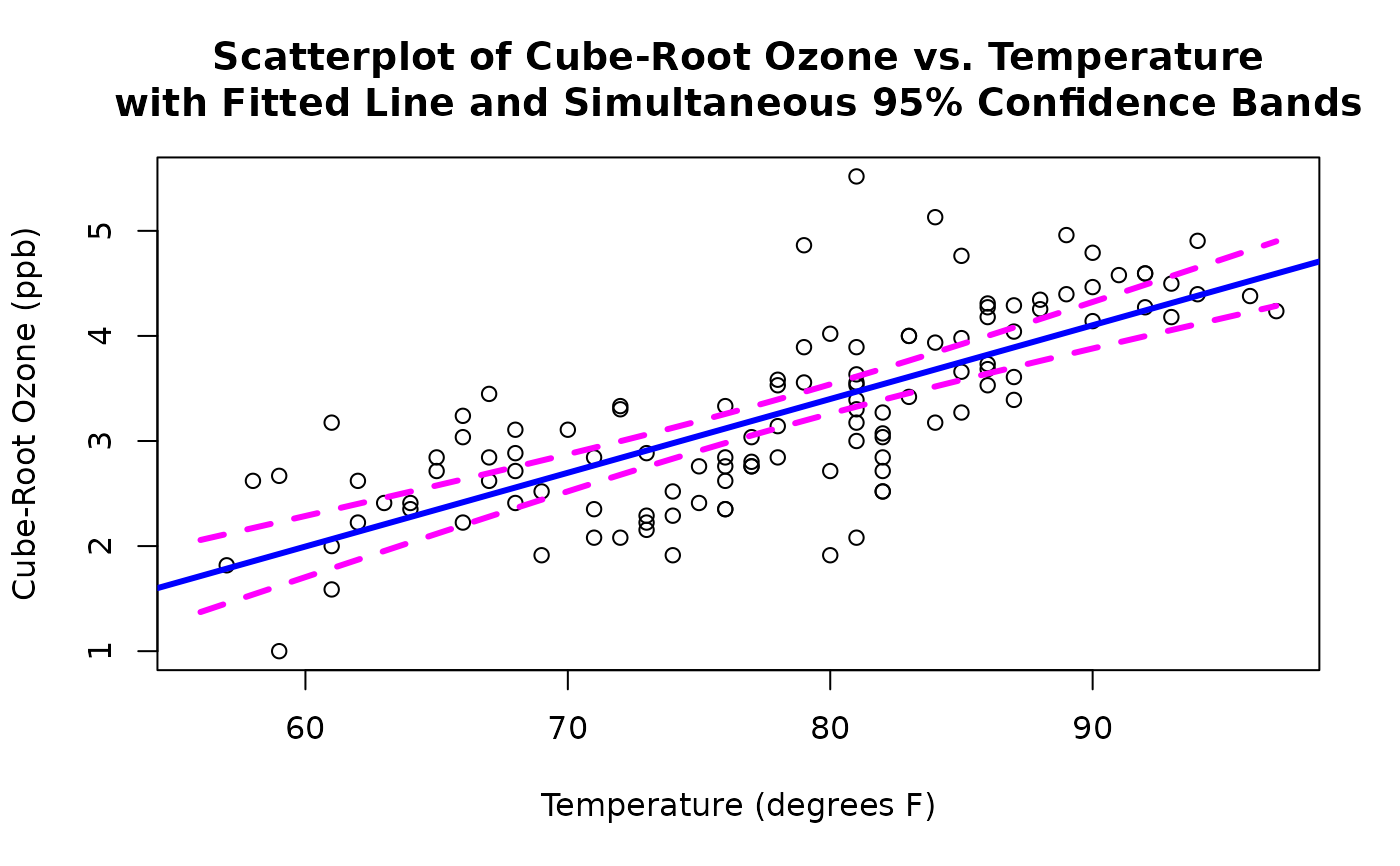Predict Method for Linear Model Fits
predict.lm.RdThe function predict.lm in EnvStats is a modified version
of the built-in R function predict.lm.
The only modification is that for the EnvStats function predict.lm,
if se.fit=TRUE, the list returned includes a component called
n.coefs. The component n.coefs is used by the function
pointwise to create simultaneous confidence or prediction limits.
# S3 method for class 'lm'
predict(object, ...)Arguments
- object
Object of class inheriting from
"lm".- ...
Further arguments passed to the R function
predict.lm. See the R help file for the R functionpredict.lm.
Details
See the R help file for predict.lm.
The function predict.lm in EnvStats is a modified version
of the built-in R function predict.lm.
The only modification is that for the EnvStats function predict.lm,
if se.fit=TRUE, the list returned includes a component called
n.coefs. The component n.coefs is used by the function
pointwise to create simultaneous confidence or prediction limits.
Value
See the R help file for predict.lm.
The only modification is that for the EnvStats function predict.lm,
if se.fit=TRUE, the list returned includes a component called
n.coefs, i.e., the function returns a list with the following components:
- fit
vector or matrix as above
- se.fit
standard error of predicted means
- residual.scale
residual standard deviations
- df
degrees of freedom for residual
- n.coefs
numeric scalar denoting the number of predictor variables used in the model
References
Chambers, J.M., and Hastie, T.J., eds. (1992). Statistical Models in S. Chapman and Hall/CRC, Boca Raton, FL.
Draper, N., and H. Smith. (1998). Applied Regression Analysis. Third Edition. John Wiley and Sons, New York, Chapter 3.
Millard, S.P., and N.K. Neerchal. (2001). Environmental Statistics with S-PLUS. CRC Press, Boca Raton, FL, pp.546-553.
Miller, R.G. (1981a). Simultaneous Statistical Inference. Springer-Verlag, New York, pp.111, 124.
See also
Help file for R function predict,
Help file for R function predict.lm,
lm, calibrate,
calibrate, inversePredictCalibrate,
detectionLimitCalibrate.
Examples
# Using the data from the built-in data frame Air.df,
# fit the cube-root of ozone as a function of temperature,
# then compute predicted values for ozone at 70 and 90 degrees F,
# along with the standard errors of these predicted values.
# First look at the data
#-----------------------
with(Air.df,
plot(temperature, ozone, xlab = "Temperature (degrees F)",
ylab = "Cube-Root Ozone (ppb)"))
# Now create the lm object
#-------------------------
ozone.fit <- lm(ozone ~ temperature, data = Air.df)
# Now get predicted values and CIs at 70 and 90 degrees.
# Note the presence of the last component called n.coefs.
#--------------------------------------------------------
predict.list <- predict(ozone.fit,
newdata = data.frame(temperature = c(70, 90)), se.fit = TRUE)
predict.list
#> $fit
#> 1 2
#> 2.697810 4.101808
#>
#> $se.fit
#> 1 2
#> 0.07134554 0.08921071
#>
#> $df
#> [1] 114
#>
#> $residual.scale
#> [1] 0.5903046
#>
#> $n.coefs
#> [1] 2
#>
#$fit
# 1 2
#2.697810 4.101808
#
#$se.fit
# 1 2
#0.07134554 0.08921071
#
#$df
#[1] 114
#
#$residual.scale
#[1] 0.5903046
#
#$n.coefs
#[1] 2
#----------
#Continuing with the above example, create a scatterplot of
# cube-root ozone vs. temperature, and add the fitted line
# along with simultaneous 95% confidence bands.
with(Air.df,
plot(temperature, ozone, xlab = "Temperature (degrees F)",
ylab = "Cube-Root Ozone (ppb)"))
abline(ozone.fit, lwd = 3, col = "blue")
new.temp <- with(Air.df,
seq(min(temperature), max(temperature), length = 100))
predict.list <- predict(ozone.fit,
newdata = data.frame(temperature = new.temp),
se.fit = TRUE)
ci.ozone <- pointwise(predict.list, coverage = 0.95,
simultaneous = TRUE)
lines(new.temp, ci.ozone$lower, lty = 2, lwd = 3, col = "magenta")
lines(new.temp, ci.ozone$upper, lty = 2, lwd = 3, col = "magenta")
title(main=paste("Scatterplot of Cube-Root Ozone vs. Temperature",
"with Fitted Line and Simultaneous 95% Confidence Bands",
sep="\n"))
 #----------
# Clean up
#---------
rm(ozone.fit, predict.list, new.temp, ci.ozone)
graphics.off()
#----------
# Clean up
#---------
rm(ozone.fit, predict.list, new.temp, ci.ozone)
graphics.off()